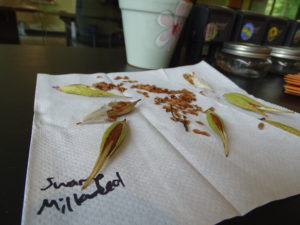Winter Sowing Native Seeds
Many Minnesota native wildflowers need extra help to sprout in the spring. Some need cold, wet conditions in order to break the seed coat. This process is called cold stratification.
How does cold stratification work?
The repeated freezing and thawing of winter breaks the tough seed coat of most prairie plants. Many prairie plants cannot germinate, or sprout, without this step.
What should I do?
The easiest way, if you’re not picky about where the plants end up, is to scatter seeds on top of the snow in January or February. You can lightly push them into the snow to keep the seeds from blowing away.
The other way is to create mini greenhouses. Put seeds and soil in plastic containers, and place them outside for the winter. Monitor them carefully in spring so they don’t over heat or dry out. Find more detailed instructions from the Hennepin County Master Gardeners here, and picture instructions here.
Don’t be disappointed if your plants don’t flower in the first year or two. In the first years, they are spending all their energy on growing long, strong roots. Have patience, and you’ll be rewarded with beautiful plants that help keep our water and the environment healthy.
